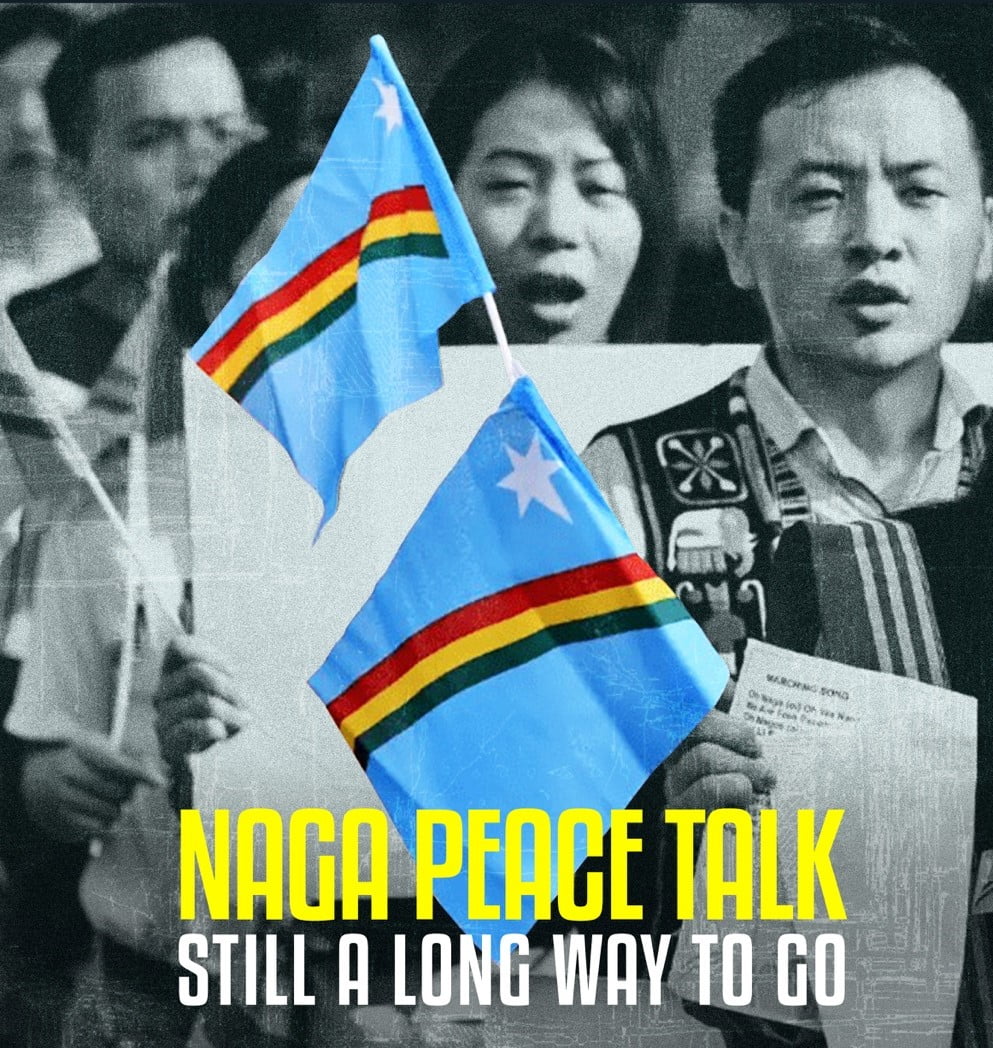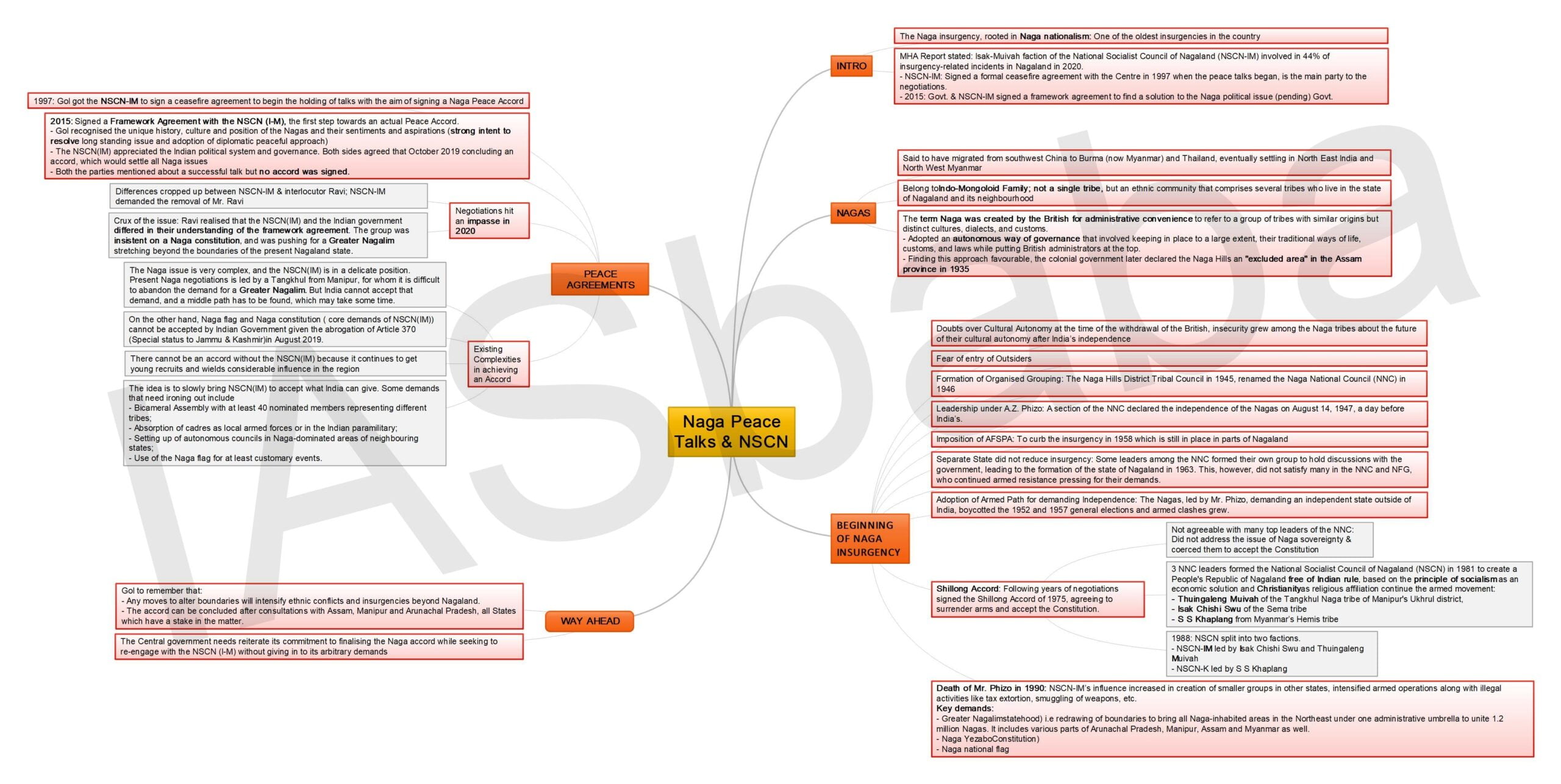Baba’s Explainer, Security Issues
Baba’s Explainer – Naga Peace Talks and NSCN
Syllabus
- GS-2: Federalism and Challenges
- GS-3: Internal Security
Context: The Naga insurgency, rooted in Naga nationalism, is one of the oldest insurgencies in the country. Recently released annual report of the Ministry of Home Affairs (MHA) stated that the Isak-Muivah faction of the National Socialist Council of Nagaland (NSCN-IM) was involved in 44% of insurgency-related incidents in Nagaland in 2020.
- One of the largest Naga groups, the NSCN-IM, which signed a formal ceasefire agreement with the Centre in 1997 when the peace talks began, is the main party to the negotiations.
- The Union government had signed a framework agreement with the NSCN-IM in 2015 to find a solution to the Naga political issue. The negotiations are yet to be concluded.

Who are Nagas?
- The Naga tribes are said to have migrated from southwest China to Burma (now Myanmar) and Thailand, eventually settling in North East India and North West Myanmar.
- Nagas belong to Indo-Mongoloid Family.
- The Nagas are not a single tribe, but an ethnic community that comprises several tribes who live in the state of Nagaland and its neighbourhood
- The term Naga was created by the British for administrative convenience to refer to a group of tribes with similar origins but distinct cultures, dialects, and customs.
- The Naga tribes are accumulated in Nagaland, Arunachal Pradesh, Manipur, and Myanmar.
- During the advent of the British and with the annexation of Assam in 1820, Nagas are largely residing in Naga hills of Assam.
- Wanting no interference in their cultural ways and customs, the Nagas did not consider themselves a part of British India.
- The British adopted an autonomous way of governance over the Nagas that involved keeping in place to a large extent, their traditional ways of life, customs, and laws while putting British administrators at the top.
- Finding this approach favourable, the colonial government later declared the Naga hills an “excluded area” in the Assam province in 1935.
Why and How did the Naga insurgency begin?
- Doubts over Cultural Autonomy: At the time of the withdrawal of the British, insecurity grew among the Naga tribes about the future of their cultural autonomy after India’s independence
- Fear of entry of Outsiders: This insecurity was accompanied by the fear of the entry of ‘plains people’ or ‘outsiders’ into their territory, which would led to demographic changes that would disturb their way of lives.
- Formation of Organised Grouping: These insecurities & fear gave rise to the formation of the Naga Hills District Tribal Council in 1945, which was renamed the Naga National Council (NNC) in 1946.
- Leadership under A.Z. Phizo: Amid uncertainties over the post-independence future of the Nagas, a section of the NNC, led by Naga leader A.Z. Phizo declared the independence of the Nagas on August 14, 1947, a day before India’s.
- Adoption of Armed Path for demanding Independence: The underground insurgency began in the early 1950s when Mr. Phizo founded the Naga Federal Government (NFG) and its armed wing, the Naga Federal Army (NFA).
- The Nagas, led by Mr. Phizo, demanding an independent state outside of India, boycotted the 1952 and 1957 general elections and armed clashes grew.
- Unlike multiple other areas in the North East, where groups were accepting some form of autonomy by forming district and hill councils under the sixth schedule of the Constitution, Nagas rejected this in favour of sovereignty.
- Imposition of AFSPA: The Central Government sent the armed forces into Naga areas to curb the insurgency and imposed the contentious Armed Forces Special Powers Act (AFSPA), 1958 which is still in place in parts of Nagaland.
- Separate State did not reduce insurgency: Some leaders among the NNC formed their own group to hold discussions with the government, leading to the formation of the state of Nagaland in 1963. This, however, did not satisfy many in the NNC and NFG, who continued armed resistance pressing for their demands.
- Shillong Accord: Following years of negotiations with the government, eventually signed the Shillong Accord of 1975, agreeing to surrender arms and accept the Constitution.
When did the NSCN come into the picture?
-
- This signing of the Shillong Accord was not agreeable with many top leaders of the NNC and those operating from Burma as the agreement did not address the issue of Naga sovereignty and coerced them to accept the Constitution.
- Three NNC leaders formed the National Socialist Council of Nagaland (NSCN) in 1981 to continue the armed movement. They were:
- Thuingaleng Muivah of the Tangkhul Naga tribe of Manipur’s Ukhrul district,
- Isak Chishi Swu of the Sema tribe
- S S Khaplang from Myanmar’s Hemis tribe

- The motto of the NSCN was to create a People’s Republic of Nagaland free of Indian rule and based on the principle of socialism as an economic solution and Christianity as religious affiliation
- With an initial cadre of 150, the NSCN soon had 3,000 recruits mainly from the Konyak and Tangkhul Naga tribes.
- In 1988, after years of infighting and violent clashes along tribal lines and over the main cause of the movement, the NSCN split into two factions.
- NSCN-IM led by Isak Chishi Swu and Thuingaleng Muivah
- NSCN-K led by S S Khaplang
- After the death of Mr. Phizo in 1990 and the split of the NNC, the NSCN-IM became the most powerful insurgent group, also playing a role in the creation of smaller groups in other states.
- Its armed operations intensified along with illegal activities like tax extortion, smuggling of weapons and so on.
- The NSCN-IM and its activities became a political roadblock for three consecutive administrations at the Centre, with Prime Ministers P V Narasimha Rao, H D Deve Gowda, and Atal Bihari Vajpayee holding multiple meetings with NSCN-IM leaders Mr. Muivah and Mr. Swu in Paris, Zurich, Geneva, and Bangkok.
What are the key demands of the NSCN-IM?
- Greater Nagalim(sovereign statehood) i.e redrawing of boundaries to bring all Naga-inhabited areas in the Northeast under one administrative umbrella to unite 1.2 million Nagas. It includes various parts of Arunachal Pradesh, Manipur, Assam and Myanmar as well.
- Naga Yezabo(Naga Constitution)
- Naga national flag.
Has there been any peace agreements between Government & Naga groups?
- In 1997, the Government of India got the NSCN-IM to sign a ceasefire agreement to begin the holding of talks with the aim of signing a Naga Peace Accord.
- The NSCN-K which initially refused to take part in any ceasefire agreement or talks with the Centre later agreed to a two-month ceasefire in 1998, which was followed by countless ceasefire extensions over the years.
- In 2015, the NSCN-K violated its ceasefire agreement, later signing an extension.
- After the 1997 ceasefire with NSCN-IM, there have been over a hundred rounds of talks spanning over 24 years between the Centre and the insurgent group, while a solution is still awaited.
- New Delhi has been holding peace parleys simultaneously with the NSCN-IM, and the Naga National Political Groups (NNPGs) comprising at least seven other extremist groups, including the NSCN (K).
- In 2015, it signed a Framework Agreement with the NSCN (I-M), the first step towards an actual Peace Accord.
- The then Joint Intelligence Chief R.N. Ravi was appointed the interlocutor for Naga peace talks and signed the Framework agreement on behalf of the Centre.
- He was later appointed as Nagaland’s Governor in 2019 to further the negotiations.
What was the Ceasefire Agreement which was signed in 2015?
- Signatories: Interlocutor R.N. Ravi signed the agreement on behalf of the Centre in presence of PM Modi. The other two signatories were leader of NSCN(IM) i.e. Isak Chishi Swu, who died in 2016 and Thuingaleng Muivah (86) who is leading the talks.
- Recognised each other’s concerns: The Government of India recognised the unique history, culture and position of the Nagas and their sentiments and aspirations. The NSCN(IM) also appreciated the Indian political system and governance. Both sides agreed that October 2019 for concluding an accord, which would settle all Naga issues
- Significance: It shows the governments strong intent to resolvethe long standing issue and adoption of diplomatic peaceful approach by Naga Society to fulfil their aspirations.
- Shrouded in Secrecy: The details of the agreement have not been made public by the government citing security reasons
- But while both the government and Naga groups said the talks successfully concluded on the government’s deadline of October 31, 2019, no accord was signed.
- The negotiations hit an impasse in 2020 with differences cropping up between NSCN-IM and interlocutor Ravi. Subsequently, NSCN-IM demanded the removal of Mr. Ravi as interlocutor.
How did things go wrong?
- Things started to go bad after Ravi realised that the NSCN(IM) and the Indian government differed in their understanding of the framework agreement. The group was insistent on a Naga constitution, and was pushing for a Greater Nagalim stretching beyond the boundaries of the present Nagaland state.
- In November 2017, Ravi signed an agreement with seven groups who had come together under the banner of the Naga National Political Groups (NNPGs), which did not include the NSCN (IM).
- The NSCN (IM), which considers itself the principal representative of Naga aspirations, has been a rival of many of the NNPG groups. In a letter to Prime Minister Narendra Modi in 2020, the IM accused Ravi of attempting to “segregate the Naga civil society”.
- After becoming Nagaland Governor in 2019, Ravi expressed uneasiness at the delay in concluding the deal. He accused NSCN (IM) for delaying the settlement by raising the contentious symbolic issues of separate Naga national flag and constitution.
- Ravi wrote a scathing letter to Nagaland Chief Minister, calling the NSCN(IM) an “armed gang”, and accused it of running a “parallel government” and engaging in extortion.
- Ravi’s open criticism made the NSCN(IM) publicly harden its position. It demanded that the Naga flag and Naga constitution were non-negotiable.
- NSCN(IM) claimed the framework agreement included the idea of unification of all Naga inhabited areas in Assam, Arunachal Pradesh, and Manipur. It accused Ravi of twisting the document by deleting key words that suggested Nagaland would co-exist with India as a sovereign.
- The counter by Ravi that “any misadventure to disintegrate the nation shall not be tolerated” angered NSCN(IM) and called for his ouster as Governor & interlocutor.
- After Ravi’s removal as the interlocutor last year, IB officer A.K. Mishra, who retired as special director, was first appointed as the centre’s adviser and then the interlocutor for the peace talks.
Amid all this, what are the complexities in achieving an accord?
- The Naga issue is very complex, and the NSCN(IM) is in a delicate position. Present Naga negotiations is led by a Tangkhul from Manipur, for whom it is difficult to abandon the demand for a Greater Nagalim. But India cannot accept that demand, and a middle path has to be found, which may take some time.
- On the other hand, Naga flag and Naga constitution which is one of the core demands of NSCN(IM) cannot be accepted by Indian Government given the abrogation of Article 370 (Special status to Jammu & Kashmir) in August 2019.
- It is important to understand that there cannot be an accord without the NSCN(IM) because it continues to get young recruits and wields considerable influence in the region.
- The idea is to slowly bring NSCN(IM) to accept what India can give.
- Some demands that need ironing out include
- Bicameral Assembly with at least 40 nominated members representing different tribes;
- Absorption of cadres as local armed forces or in the Indian paramilitary;
- Setting up of autonomous councils in Naga-dominated areas of neighbouring states;
- Use of the Naga flag for at least customary events.
What is the way ahead?
- Any moves to alter boundaries will intensify ethnic conflicts and insurgencies beyond Nagaland.
- The accord can be concluded after consultations with Assam, Manipur and Arunachal Pradesh, all States which have a stake in the matter.
- The Central government needs reiterate its commitment to finalising the Naga accord while seeking to re-engage with the NSCN (I-M) without giving in to its arbitrary demands.
Mains Practice Question – What are the challenges in finalising the peace accord with Naga insurgent groups? Suggest measures to move beyond the current status.
Note: Write answers to this question in the comment section
Mind Map

DOWNLOAD MIND MAP – CLICK HERE













